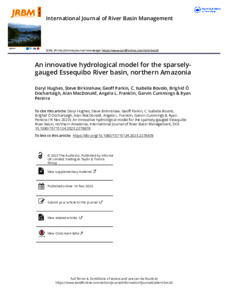An innovative hydrological model for the sparsely-gauged Essequibo River basin, northern Amazonia
Hughes, Daryl; Birkinshaw, Steve; Parkin, Geoff; Bovolo, C. Isabella; O Dochartaigh, Brighid; MacDonald, Alan  ORCID: https://orcid.org/0000-0001-6636-1499; Franklin, Angela L.; Cummings, Garvin; Pereira, Ryan.
2023
An innovative hydrological model for the sparsely-gauged Essequibo River basin, northern Amazonia.
International Journal of River Basin Management.
https://doi.org/10.1080/15715124.2023.2278678
ORCID: https://orcid.org/0000-0001-6636-1499; Franklin, Angela L.; Cummings, Garvin; Pereira, Ryan.
2023
An innovative hydrological model for the sparsely-gauged Essequibo River basin, northern Amazonia.
International Journal of River Basin Management.
https://doi.org/10.1080/15715124.2023.2278678
![[img]](/536257/1.hassmallThumbnailVersion/An%20innovative%20hydrological%20model%20for%20the%20sparsely-gauged%20Essequibo%20River%20basin%20northern%20Amazonia.pdf)
|
Text (Open Access Paper)
An innovative hydrological model for the sparsely-gauged Essequibo River basin northern Amazonia.pdf - Published Version Available under License Creative Commons Attribution 4.0. Download (3MB) | Preview |
Abstract/Summary
Tropical river basins – crucial components of global water and carbon cycles – are threatened by logging, mining, agricultural conversion, and climate change. Thus, decision-makers require hydrological impact assessments to sustainably manage threatened basins, such as the ∼68,000 km2 Essequibo River basin in Guyana. Emerging global data products offer the potential to better understand sparsely-gauged basins. We combined new global meteorological and soils data with established in situ observations to build the first physically-based spatially-distributed hydrological model of the Essequibo. We developed new, open source, methods to translate global data (ERA5-Land, WFDE5, MSWEP, and IMERG) into a grid-based SHETRAN model. Comparing the performance of several global and local precipitation and evaporation datasets showed that WFDE5 precipitation, combined with ERA5-Land evaporation, yielded the best daily discharge simulations from 2000 to 2009, with close water balances (PBIAS = −3%) and good discharge peaks (NSE = 0.65). Finally, we tested model sensitivity to key parameters to show the importance of actual to potential evapotranspiration ratios, Strickler runoff coefficients, and subsurface saturated hydraulic conductivities. Our data translation methods can now be used to drive hydrological models nearly anywhere in the world, fostering the sustainable management of the Earth’s sparsely-gauged river basins.
| Item Type: | Publication - Article |
|---|---|
| Digital Object Identifier (DOI): | https://doi.org/10.1080/15715124.2023.2278678 |
| ISSN: | 1571-5124 |
| Additional Keywords: | GroundwaterBGS |
| Date made live: | 16 Nov 2023 14:46 +0 (UTC) |
| URI: | https://nora.nerc.ac.uk/id/eprint/536257 |
Actions (login required)
 |
View Item |
Document Downloads
Downloads for past 30 days
Downloads per month over past year


 Altmetric
Altmetric Altmetric
Altmetric